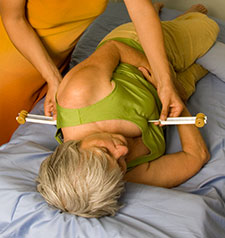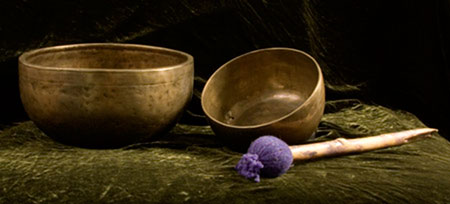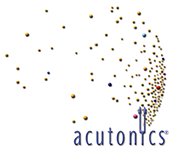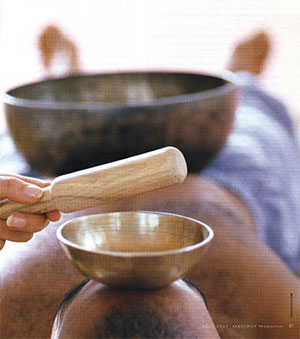Ellen F. Franklin, PhD
Massage Magazine, April 2007
“The knower of the mystery of sound knows the mystery of the whole universe.” —Hazrat Inayat Khan
Shiatsu practitioner Elfi Six incorporates gongs, tuning forks, chimes, bells, singing bowls, rattles, hand drums and the Kalimba (thumb piano) into her clinical practice in the Bershires in Massachusetts, and into her job at Canyon Ranch health resort in Lenox, Massachusetts. Six, who recently celebrated her 25th year in practice, believes that sound therapy beautifully supports her hands-on work.
“Imagine different ancient universal-sound qualities traveling along the acupuncture channels that in certain areas can be clogged—or if not dispersed, would lead to disease, pain or other discomfort,” she explains.
Six is among the many modern health-care practitioners who are putting the ancient practice of sound healing to a new rhythm of care.
Ancient cultural traditions and healing practices all over the world have utilized music, voice and sound to heal. In ancient Hellenic culture, the flute was played to ease the pain of gout; in the Christian Bible, David plays the harp to ease King Saul’s depression; and in spiritual traditions around the globe, chanting and prayer have been used for thousands of years to align body, mind and spirit.
Today, many health-care practitioners are integrating sound-healing tools into the therapeutic environment with profound results. These tools include the voice, harp, Tibetan bowls and bells, tuning forks, drums, rattles and gongs. There is a growing body of research that supports what people have known intuitively throughout time; Sound therapy works.2,3,4,5
Vibratory Motion
Sound therapy is a form of vibrational, energetic and harmonic healing. Our bodies function best when there is harmony, resonance and balance. As our hearts beat our lungs regulate breath, our organs work in mutual support and resonance with each other.
Ancient East Asian Medicine physicians discovered a system of cyclic energy that flows along specific pathways, or points, in the body. Each pathway is associated with a particular physiological system and internal organ. Disease arises when there is imbalance, or disharmony, along the body’s energetic pathways.6 These pathways (meridians) of energy can be accessed therapeutically through touch and sound to relieve chronic conditions.
The system of sound healing that I work with draws heavily on this Eastern perspective, as well as contemporary cell biology and quantum physics, which provide increasing evidence that the vibratory motion of energy is found throughout nature and the universe, and contained within our cells.7
I was first exposed to sound therapy when I was suffering from a serious health condition and reluctantly went to see an acupuncturist who also worked with tuning forks, Tibetan bowls, bells and gongs. After the first treatment I could feel my body readjusting, my breath came more easily, and some of the pain and musculoskeletal problems that I had experienced were greatly reduced.
The primary treatment consisted of the application of tuning forks to key acu-points, Tibetan bowls placed on my body, and gongs sounded; few acupuncture needles were used. By the third session I was able to stop using an inhaler for asthma, and was taught to use tuning forks for self-care to open up my airways. The work was so profound that it changed the course of my life. Now, more that 15 years later, my life’s work is focused on education, research and writing about the beneficial effects of sound healing.
 Resonating with the Core Essence
Resonating with the Core Essence
Everything around us is in a state of constant vibratory motion, generating sounds both audible and inaudible that can be harnessed to assist the healing process.
Polarity practitioner Micah Dobush, of Mt. Shasta, California, uses voice—vocalizing, toning and chanting seed mantras (a single syllable sound like aum)—and Tibetan bowls and tuning forks in his sessions. “The voice is the perfect instrument,” he says. “I have sung to clients while holding certain chakras or blocked areas, and used singing bowls for many years for balancing, clearing and vibrational alignments.”
Sound vibrations impact us both positively and negatively. It is easy to recognize the physical impacts experienced from sounds such as fingernails scratching a blackboard, a jackhammer in the street, honking horns in a busy intersection, the steady beat of rock music at the gym. Now imagine the impact of gentle, healing sounds on the body.
“One of the things I love most about working with sound is that each session is a unique creative collaboration between the client and the practitioner,” says Carmen Cicotti form Lopez Island, Washington. She practices shiatsu, massage, cranialsacral therapy and Acutonics (a trademarked form of sound healing).
“By adding sound-healing tools, I am not just releasing tension and disharmony in the physical body but am able to access the deeper emotional levels to unlock the stores of memory lodged in the muscles,” she addeds.
The beneficial effects of music for relaxation and stress reduction have been heavily researched,8,9,10,11 and many practitioners already integrate music into their bodywork sessions. The human body is more than 70 percent water—even our bones and marrow are 25 percent water—and because sound travels more than four times faster in water, the body acts as a perfect resonator.12,13
New York-based oncologist Mitchell Gaynor, M.D., believes that sound-based therapies are one of the most powerful healing modalities, and that when we are attuned to the delicate vibrations of the universe, we are better able to resonate with our core essence, or true self.
“I believe sound and music are the next important integrative tools.” —Oncologist Mitchell Gaynor, M.D.
He incorporates a variety of sound-healing techniques in his support groups for cancer patients, including guided meditation and crystal and Tibetan healing bowls.14 Gaynor’s new CD set, Meditations and Music for Sound Healing (Relaxation Co., 2006), was featured on Oprah and Friends Radio.
“I believe sound and music are the next important integrative tools, which will facilitate bringing healing to seriously ill patients as well as those suffering from chronic illness,” Gaynor says. “As a cancer specialists, I see the miracles of healing every day; a wakening each patient’s healing wisdom and potential is a doctor’s critical task.”
Sound Healing and Body Work
In her massage and reflexology practice, Maren Good of Westfield, New Jersey, integrates a range of tools, including Tibetan bowls, the Tibetan bell and dorje, and hand chimes.
“I use a Tibetan bowl at the beginning of a massage session as a diagnostic tool. By scanning the body with the bowl and observing where sound is reflected or absorbed, I have a clear indication of where the body needs to be balanced,” she says.
Good also uses tuning forks directly on tissue to break up muscle spasms, to balance the chakras, and for grounding at the beginning and end of a session. She integrates tuning forks into her reflexology work as well. “[Tuning forks have] helped to save my hands,” she says.
Six often starts a session with the planetary Earth gong, and has the client stand in front of the instrument when it is struck. The vibrations of the gong travel deeply into the body and can be extremely effective in reducing stress. If a client is not responding to other methods, she will use the rattle or play the didgeridoo to loosen any stuck energy and bring relief. Tuning forks also provide a noninvasive way to access sensitive areas.
“Through the application of tuning forks, the layers of resistance just melt away,” Six says. “The common denominator for both shiatsu and sound therapy is the goal of harmonizing the energy flow. Once the person feels balance, the shoulder problems, sciatica or back pain often lessen or resolve, as do many other uncomfortable emotional states and body symptoms.”
When you begin to integrate sound-healing tools into your practice, start slowly and engage your clients in a discussion of what you would both like to accomplish in the session. Remember that sound is a powerful healing tool; a little goes a long way. If you are unsure of were to begin, I encourage you to take a class and learn more about the incredible transformational power of sound therapy.
Sound-Healing Tools
Many sound-healing practitioners speak of the critical role that intention—setting a clear energetic vision for each session—plays in their healing work. Intention is equally important in the selection of tools.
There are a wide variety of tools available, and price is not always the only indicator of quality. You need to hear them, feel them, and have some idea of the provenance. Where did the tools come from? Are they fair-trade objects—have craftsmen and merchants been fairly compensated for sound tools purchased from India or Tibet, or from the aboriginal people of Australia? The intention in the creation and sale of tools used in healing work are as important as the sound quality and harmonics.
Resonance is also important. If you intend to incorporate several different tools, get a sense of how they resonate with one another. Also consider how the tools will work together. If you’re selecting Tibetan bowls, for example, choose several sizes. A 12-inch bowl can be placed on the sacrum, but you would want a much smaller bowl for the heart area.
Most of the tools discussed below have been used for thousands of years, in celebration, ceremony, ritual and healing — from the drum that plays the heartbeat of the universe to the didgeridoo, which the Aboriginal people believe sounded the world into existence. Modern healing practices draw upon these traditional methods and honor their wisdom. Each tool can be used independently or in concert with other tools to bathe the body in sound.
 Tibetan Singing Bowls
Tibetan Singing Bowls
Tibetan bowls were traditionally used by Buddhist monks in spiritual practice, and are still used as meditation aide. Traditionally they were made of an alloy of metals. The combination and proportion of the metals used, wall thickness and bowl size determined each instrument’s unique harmonics.
Today singing bowls are used on and over the body to align and balance energy in the physical and subtle-energy, or etheric, fields. New and antique bowls are commonly used in healing, although the metal alloys and techniques traditionally used to make the bowls are difficult to replicate in modern manufacturing.
Tinchas
Tinchas are hand-held cymbals traditionally used in Buddhist and shamanic traditions. The clear sound made when the cymbals are struck together was used to begin or end meditation or ritual. Today they are used as a sound-healing tool to lift and transform dense energy patterns in the etheric field. They come in different sizes, and are either smooth or decorated with sacred symbols.
Crystal Singing Bowls
Unlike Tibetan singing bowls, crystal bowls are made from pure crushed quartz heated to about 4,000 degrees in a centrifugal mold. They are used for healing in the etheric field and to work with the chakras. They have a bright, resonant tone and a more watery quality than Tibetan bowls.
 Bell and Dorje
Bell and Dorje
The bell and dorje are used in Buddhist ceremony, and symbolize the duality (yin and yang nature) of life. In Shamanic traditions, the sound of the bell represents the element of air, the realm of the spirits, and the ether that transmits and is the transmitter. In contemporary healing practices, the bell can be used over the chakras or in the etheric field, and is sometimes rung over a singing bowl.
Tuning Forks
Tuning forks are versatile tools that can be applied directly to acupressure, trigger or pain points, in order to access the chakra- and meridian-energy systems. I work with forks tuned to the frequencies of the Earth, Moon, Sun and planets15 to help bring people into alignment with the sounds of the cosmos, known since antiquity as the music of the spheres.4,5,16
Susan Myers, a neuromuscular therapist in Taos, New Mexico, says, “When I work with specific muscle fibers and find a trigger-point nodule, I will use the tuning fork to shift the contraction when palpation pressure is not releasing the fibers of the muscle.”
Planetary Gongs
These symphonic gongs are rich in overtones and undertones. Tuned to the frequencies of the planets, they resonate harmonically with the cycles and rhythms of the cosmos. Their complex vibrations support the body’s natural frequencies and promote healing at a deep level.
Didgeridoo
The didgeridoo, an Aboriginal healing instrument, is played using a complex breathing-and-humming technique, and positioned at the client’s feet or over his solar plexus. Its deep, resonant sound grounds and connects the client to his physical body.
Rattles
The rattle is one of the oldest healing instruments, and has been used around the world by many cultures. It is used in contemporary healing to loosen negative energies and emotional patterns.
Drums
Drums represent the heartbeat of the Earth. Their intense reverberations help ground energy in the body. Drumming and rattling can be used together to disperse blocked energy in the chakras and awaken the entire energetic system.
Footnotes
- Khan, H.I., The Music of Life. Omega Publications, 1983
- Gerber, R., Vibrational Medicine: New Choices for Healing Ourselves. Bear & Co., 1988
- Nakash, S., Music Therapy at the End of Life. Jeffrey Books, 2005
- Carey, D., de Muynck, M., Acutonics: There’s No Place Like Ohm, Sound Healing, East Asian Medicine, and the Cosmic Mysteries. Devachan Press, 2002
- Carey, D., Franklin, E., MichelAngelo, Ponton, J., Ponton, P., Acutonics From Galaxies to Cells: Planetary Science, Harmony, and Medicine. Devachan Press 2002.
- Kendall, D.E., DAO of Chinese Medicine Understanding An Ancient healing Art. Oxford University Press, 2002.
- Groleau, R., Resonance in Strings. Nova The Elegant Universe (Available from: www.pbs.org/wgbh/nova/elegant/resonance.html), 2006
- Salmon, E., Kim, M., Beaulieu, J., Stefano, G.B., Sound Therapy Induced Relaxation: Down Regulating Stress Processes and Pathologies. Medical Science Monitor, 2002.
- Mornhinweg, G.C., Effects of Music Preference and Selection on Stress Reduction. Journal of Holistic Nursing, 1992, Vol. 10 (No. 2): pp. 101-109.
- Stadley, J., Ph.D., R.M.T., Hanser S.B., Ed.D., R.M.T.-BC, Music Therapy Research and Applications in Pediatric Oncology. Journal of Pediatric Oncology Nursing, 1995, 12, No. 1 (January): pp. 3-8
- Hanser, S., Music Therapy and Stress Reduction Research. Journal of Music Therapy, 1985. 22; pp. 193-206.
- Maurer, J.A., Research in Underwater Sound. (1998) http://ccrma.standord.edu/-blackrse/h20.html.
- Watson, P., Watson, I.D., Batt, R.D., Total body water volumes for adult males and females estimated from simple anthropometric measurements. American journal of Clinical Nutrition, 1980. Vol 33, 27-39.
- Gaynor, M.L., The Healing Power of Sound. Shambhala, 1999.
- Cousto, H., The Cosmic Octave. (Baker, C., Trans.). Life Rhythm Publications, 1988.
- Godwin, J., The Harmony of the Spheres: a Sourcebook of the Pythagorean Tradition in Music. Inner Traditions International. 1993.

